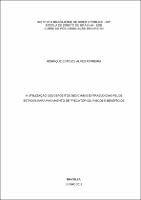Use este identificador para citar ou linkar para este item:
https://repositorio.idp.edu.br//handle/123456789/2654| Título: | A utilização dos depósitos judiciais e extrajudicias pelos estados para pagamento de precatórios: riscos e benefícios |
| Autor(es): | Ferreira, Henrique Esteves Alves |
| Orientador(es): | Afonso, José Roberto R. |
| Palavras-chave: | Depósito judicial;Precatórios;Poder Executivo;Reflexos;Constitucionalidade |
| Data de submissão: | 2018 |
| Resumo: | Os depósitos judiciais e administrativos representam quantias astronômicas que alcançam
atualmente a casa dos doze dígitos, sendo que com a chegada da crise financeira brasileira,
soluções criativas emergiram, entre estas a utilização de tais cifras para o pagamento de
compromissos dos entes do Judiciário e, recentemente, do Executivo. No intuito de regular a
matéria o Congresso Nacional promulgou a Lei Complementar 151, de 05 de agosto de 2015,
definindo regras para a transferência de valores para a conta única dos respectivos Estados,
Municípios e Distrito Federal, inclusive instituindo um fundo de reserva garantidor. Ao
mesmo modo, vários governos editaram leis próprias com limites, fundo e destinações
díspares, o que provocou extrema insegurança jurídica e instabilidade em toda sistemática,
tendo sido a maioria absoluta alvo de questionamento por meio de ações diretas de
inconstitucionalidade perante o Supremo Tribunal Federal. Em sequência, adveio a Emenda
Constitucional 94/2016, alterada pela EC 99/2017. A matéria se mostra complexa, tendo sido
editadas mais de setenta leis e propostas mais de trinta ADI, o que é elevado pelo temor de um
possível estado de insolvência dos Entes Subnacionais. Neste âmbito, este trabalho se propõe
a analisar a nova sistemática sob a ótima dos reflexos gerados à população e aos Estados,
valendo-se de minuciosa coleta de dados dos julgados da Suprema Corte, pesquisa
bibliográfica e documental, maximizado pelo estudo de três diferentes casos e abalizado por
dez entrevistas. O objetivo é compreender e evidenciar os reflexos positivos e negativos da
nova operação, verificados por meio do pagamento do histórico estoque de precatórios em
mora. Os resultados apontam que a sistemática se revelou prática para pagamento dos créditos
de precatórios, como permitiu às unidades da Federação que colocassem em dia sua
obrigação, mesmo que momentaneamente, porém insuficiente para se afirmar ser benéfica,
posto as incertezas futuras em decorrência da escassez de estudos técnicos. No fim, a
alternativa se mostrou multidimensional e complexa, devendo ser tratada no âmbito macro do
Federalismo Fiscal, evitando que se maximize o endividamento futuro. |
| Abstract: | Judicial and administrative deposits represent astronomical amounts that currently reach twelve-digit figures, and with the arrival of the Brazilian financial crisis, creative solutions have emerged, among them the use of such figures for the payment of commitments of Judiciary entities and, recently, of the Executive. In order to regulate the matter, the National Congress enacted Complementary Law 151, of August 5, 2015, defining rules for the transfer of amounts to the single account of the respective States, Municipalities and Federal District, including establishing a guarantee reserve fund. In the same way, several governments have edited their own laws with limits, background and disparate destinations, which provoked extreme legal insecurity and instability in all systematic, being the absolute majority questioned through direct actions of unconstitutionality before the Federal Supreme Court. Subsequently, Constitutional Amendment 94/2016 was amended, as amended by EC 99/2017. The matter is complex and more than seventy laws and proposals have been issued for more than thirty ADI, which is raised by the fear of a possible state of insolvency of the Subnational Entities. In this context, this work aims to analyze the new system under the optimum of the reflexes generated to the population and the States, using a thorough collection of Supreme Court data, bibliographical and documentary research, maximized by the study of three different cases and supported by ten interviews. The objective is to understand and evidence the positive and negative effects of the new operation, verified through payment of the historical stock of delinquent “Government debt” (to the common citizen). The results indicate that the system proved to be a practice for the payment of “Government debt” (to the common citizen) credits, as it allowed the Federation units to update their obligation, even momentarily, but insufficient to claim to be beneficial, given future uncertainties due to the shortage of technical studies. In the end, the alternative was multidimensional and complex and should be dealt with in the macro-framework of Fiscal Federalism, avoiding the maximization of future indebtedness. |
| URI: | https://repositorio.idp.edu.br//handle/123456789/2654 |
| Aparece nas coleções: | Mestrado Profissional em Administração Pública |
Arquivos associados a este item:
| Arquivo | Descrição | Tamanho | Formato | |
|---|---|---|---|---|
| HENRIQUE ESTEVES.pdf | 2.12 MB | Adobe PDF |  Visualizar/Abrir |
Os itens no repositório estão protegidos por copyright, com todos os direitos reservados, salvo quando é indicado o contrário.
